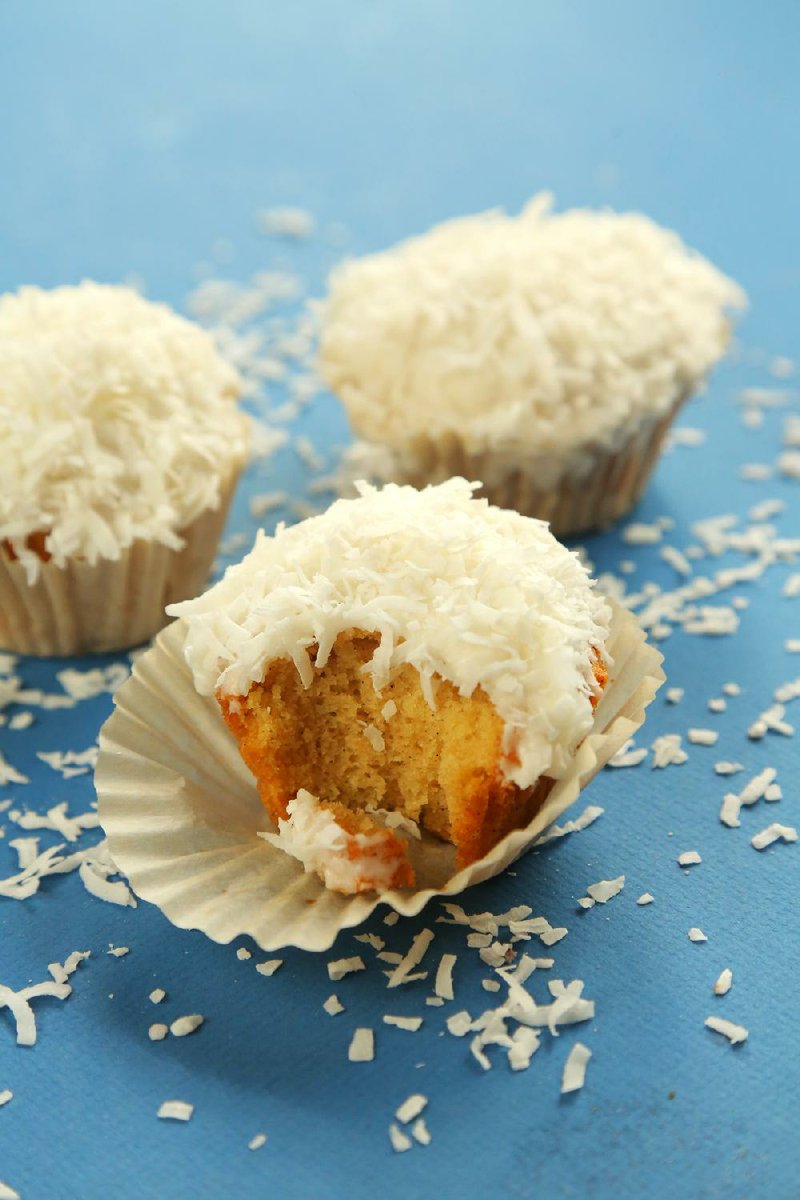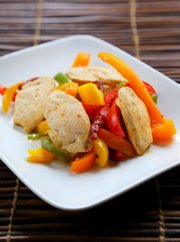My love affair with coconut goes back to my childhood when my father would crack open a fresh coconut with a hammer and separate the dense “meat” from the shell to give all of us a sweet, chewy treat. I can still feel the way the fresh coconut squeaked against my teeth.
Candy, cakes, cookies, ice cream, Asian sauces, on shrimp - I’ve eaten coconut every way imaginable. But I hadn’t cooked with coconut oil until a few months ago.
Now that I have, I’m hooked. The slightly sweet oil adds a subtle flavor to all kinds of dishes, although it’s best used as a substitute for butter or oil in baking. It’s also delicious right out of the jar; spread it instead of butter on toast, pancakes or English muffins.
Coconut oil is all the rage. If you believe everything you read, you can not only cook with it but slather it on to moisturize your skin or heal wounds. It has even been touted as a weight-loss aid (not that I buy that). Demonized in the 1960s as an artery-clogging, heart-stopping substance, its reputation was redeemed when scientists and the medical community recognized that it contains no cholesterol and can be good for you. According to webmd.com, unrefined coconut oil contains a high concentration of lauric acid, an essential fatty acid that boosts the immune system.
But all coconut oil isn’t created equal.
The variety of coconut oil maligned for years was “hydrogenated,” a process of adding hydrogen to oil, then subjecting it to high pressure and temperature to create fats that are solid at room temperature. Hydrogenated oils contain “trans fat,” which the Food and Drug Administration has linked to heart disease.
The type of coconut oil I cook with is “virgin” or “unrefined,” which means that it is cold-pressed from freshly harvested coconut meat. Having never been subjected to heat, the natural flavor, aroma and scent are intact. Want to give your nose a thrill? Just open a jar and sniff.
Since coconut oil has become more popular, you no longer have to go to a specialty store to buy it. I get mine at the local supermarket, where it sits on the shelves alongside other vegetable oils - but be prepared to pay more, as coconut oil prices range from $7 to $12 or more per pint. I prefer organic coconut oil, so I usually pick mine up from the natural foods section. The oil, sold in glass jars, should be a pearlescent white solid. If it has a dark or yellowish tint, it’s rancid and should be avoided.
Coconut oil stores well unrefrigerated for months. If kept in a cabinet, it’ll usually retain solid form (which is more of a semisolid, so don’t expect the density of shortening or butter). If you leave it on the counter or next to the stove, it’ll begin to soften and often liquefy. No problem. To resolidify it, just move it to a cooler place.
I’ve experimented using coconut oil in a variety of dishes, sometimes adapting recipes or creating my own. Below is a selection of my quick and easy favorites.
Some things to consider when using coconut oil:
When a recipe specifies liquid oil, just heat the oil for a few seconds or leave it sitting in a warm area of the kitchen.
It’s lighter than other vegetable oils, but a little still goes a long way. When substituting for butter or margarine, start out with a smaller amount than what’s specified. If you need more, you can add it.
When sauteing with coconut oil, take care not to overheat it. If the oil takes on a yellowish cast, it’s ruined and you need to start over.
The Coconutty Nut Butter recipe makes a spread that’s less dense and sticky than peanut butter. You might want to play around with the amount of oil to get a consistency you like. Also, it solidifies in the refrigerator, which makes it harder to spread. Just leave it on the counter for a few minutes to soften before using.
If you use coconut oil to cook, be aware that it imparts a slightly sweet, coconut flavor. If you don’t like sweet meat, you’ll want to save coconut oil for other dishes.
This cupcake recipe is vegan, which means it contains no eggs, dairy, or other animal products. But don’t worry, even without eggs the batter will rise and the cupcakes will hold together. You may raise an eyebrow, as I did, when seeing that you need to add vinegar, but do not leave it out. It reacts with the baking soda to make the batter rise and fluff up. Enjoy.
Fluffy Coconut Cupcakes
1 ¾ cups cake flour or all purpose flour
¾ cup granulated sugar
1 teaspoon baking powder
1 teaspoon baking soda
½ teaspoon salt
1 cup unsweetened coconut milk
1/3 to 1/2 cup unrefined coconut oil, liquefied (see note)
2 tablespoons vanilla extract
1 tablespoon apple cider vinegar
Coconut Frosting (recipe follows)
Shredded coconut, optional
Heat oven to 350 degrees and line cupcake pans with 12 paper cupcake liners.
In a large bowl, whisk together the flour, sugar, baking powder, baking soda and salt.
In a separate bowl, whisk together coconut milk, oil, vanilla and vinegar. Pour the wet mixture over the dry mixture and whisk until just combined. Do not over-mix.
Fill the cupcake wells about two-thirds full with batter. Bake at 350 for 18 to 25 minutes, or until a wooden pick inserted in near the center of the cupcake comes out clean.
Cool cupcakes completely before frosting. If desired, sprinkle frosted cupcakes with shredded coconut.
Makes 12 cupcakes.
Note: To liquefy the oil, heat it for a few seconds or place the jar in a warm area of the kitchen.
Coconut Frosting
½ cup unrefined coconut oil
1 ½ to 2 cups confectioners’ sugar
1 teaspoon vanilla extract
2 to 3 tablespoons unsweetened coconut milk
Using a hand-held mixer, beat the coconut oil until smooth. With the mixer on low, add 1 ½ cups of the confectioners’ sugar, the vanilla and 1 tablespoon coconut milk at a time and beat until the frosting becomes of a spreading consistency. Adding more milk and/or sugar as necessary to achieve the desired consistency. Beat on high for 2 minutes until light and fluffy.
Recipe adapted from chefchloe.com
Serve this colorful stir-fry as a side dish or add thinly sliced chicken breast for a one-dish meal over wholewheat linguine or brown rice.
Coconut Confetti Stirfry
3 to 5 tablespoons unrefined coconut oil
1 clove elephant garlic OR 6 cloves regular garlic, chopped
1 boneless, skinless chicken breast, thinly sliced, optional
1 red or orange bell pepper, cored and cut into strips
1 yellow bell pepper, cored and cut into strips
1 green bell pepper, cored and cut into strips
1/3 cup sun-dried tomatoes, coarsely chopped and soaked for 10 minutes in just-boiled water
Sea salt, to taste
Ground red pepper (cayenne), to taste
Heat oil in a large iron skillet on medium heat, then add chopped garlic and saute until translucent. Add chicken, if using, and cook, stirring, until all pieces have been seared.
Increase heat to high, then add peppers and drained tomatoes.
Stir with spatula, making sure all pieces are coated with oil.
Sprinkle with salt and cayenne pepper to taste. Reduce heat to medium, continue stirring until peppers are slightly browned on the edges and have lost their crispness, and the chicken, if using, is cooked through.
Makes 2 main-dish or 4 side-dish servings.
Coconutty Nut Butter
2 cups peanuts, almonds OR cashews
Up to ¾ cup unrefined coconut oil
2 tablespoons honey, optional
1 teaspoon sea salt, or to taste
Place nuts in a food processor and grind to a fine powder. Leaving the powder in the food processor, add the coconut oil a little at a time and process until you get the smoothness and consistency you desire; you may not need all of the oil. Then mix in the honey if you’d like more sweetness than the coconut oil provides. Add salt. The “butter” will be kind of runny, but will solidify when chilled in the refrigerator. Keep refrigerated in an airtight container, but serve at room temperature.
Makes about 2 cups.
Recipe adapted from Nourishing Traditions by Sally Fallon
Coconut Potato Bake
¼ cup unrefined coconut oil
4 large russet potatoes
1 clove elephant garlic OR 4 cloves regular garlic, finely chopped
Sea salt, to taste
Heat oven to 400 degrees.
Melt the coconut oil in the oven in a large baking dish.
Peel and thinly slice the potatoes. Add potatoes and garlic to the baking dish and stir well to coat with oil. Sprinkle with salt to taste.
Bake 20 minutes, then stir and bake 20 minutes more or until lightly browned.
Makes 4 servings.
Variation:
Coconut Chile Potato Bake, add a chopped serrano chile pepper (seeds removed) to the potato-garlic mixture.
Chocolate Coconut Bars
¼ cup unrefined coconut oil
1/3 cup honey
½ cup Nutella or other chocolate-hazelnut spread
¼ cup unsweetened cocoa powder
¼ cup ground flaxseed, optional
1 ½ cups quick oats
½ cup shredded coconut
½ cup dried cherries, optional
Line a baking dish with wax- or parchment paper.
Melt coconut oil, honey and Nutella together in a small saucepan over low heat, stirring constantly. Remove from heat and add remaining ingredients.
Stir until well blended. Spread mixture evenly in prepared pan.
Refrigerate until set. Cut into bars. Store in the refrigerator.
Recipe adapted from themarathonmom.com
Food, Pages 31 on 06/26/2013


